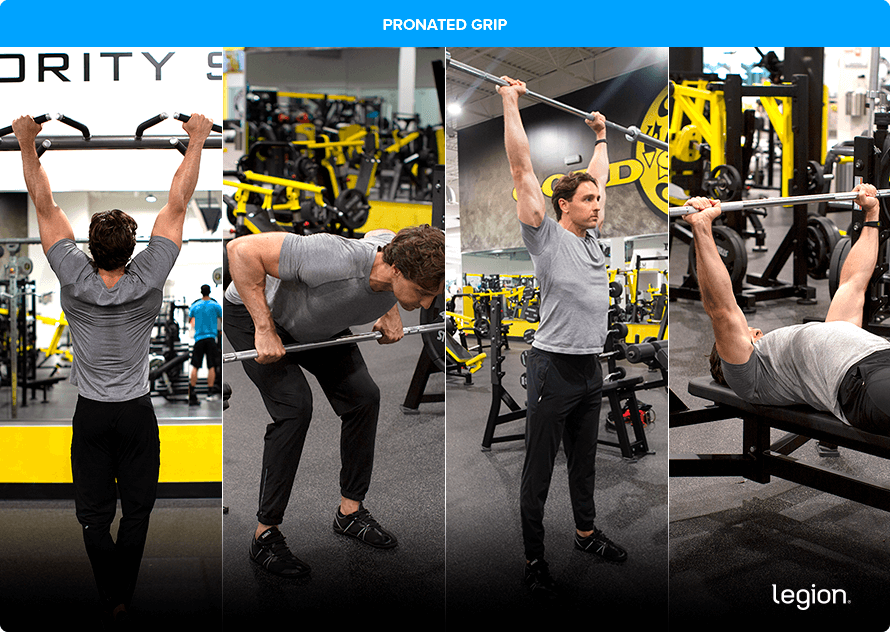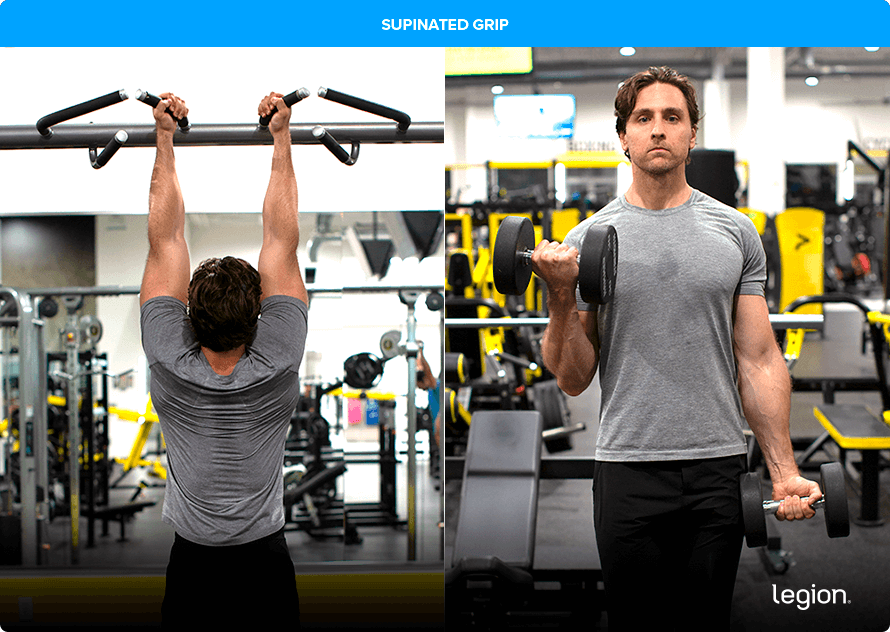Weightlifters regularly argue over the merits of pronation vs. supination with regard to grip.
Many believe changing how you grip a weight significantly impacts which muscles you train.
For instance, they say performing pulling exercises with a pronated grip greatly increases how much work your back muscles have to do, whereas using a supinated grip boosts biceps involvement.
Are these ideas true?
Is there a clear winner in the pronate vs. supinate debate, or are the differences more nuanced than they appear?
Get evidence-based answers in this article.
What Is a Pronated Grip?
Pronation refers to a hand and wrist position in which your palms face backward when your arms are by your sides.
A “pronated grip,” often referred to as an “overhand grip,” is a method of gripping where your hand is in a pronated position.
A pronated grip can look different depending on where you position your arms relative to your body. For example, if you hold a barbell with a pronated grip and your arms straight out in front of you, your palms will face the floor.
In contrast, if you hold a barbell with a pronated grip and your arms overhead, your palms will face forward.
Exercises that use a pronated grip include the barbell row, pull-up, bench press, and overhead press. Here’s how these exercises look:

What Is a Supinated Grip?
Supination refers to a hand and wrist position in which your palms face forward when your arms are by your sides.
A “supinated grip,” commonly called an “underhand grip,” is a way of gripping where your hand is in a supinated position.
Like a pronated grip, a supinated grip changes depending on how you position your arms. For instance, if you hold a barbell with a supinated grip and your arms straight out in front of you, your palms will face the ceiling.
Conversely, if you hold a barbell with a supinated grip and your arms overhead, your palms will face backward.
Exercises that use a supinated grip include the bicep curl and chin-up. Here’s how these exercises look:

Other Types of Grips
There are other ways to grip a weight beyond pronated and supinated grips.
Here are some other grips commonly used in strength training.
Mixed Grip
Weightlifters often use a mixed or “alternated grip” for deadlifts. It involves one hand using a pronated grip and the other a supinated grip.
The advantage of a mixed grip is that it helps prevent the bar from rolling out of your hands, allowing you to lift heavier weights. However, it can lead to muscle imbalances over time, and when the weights get heavy, it increases the risk of suffering a biceps tear in your supinated hand.
Neutral Grip
In a neutral grip, your palms face each other. Weightlifters commonly use it for variations of the biceps curl, shoulder press, and cable row. It’s popular because it’s gentler on the wrists and elbows, making it more suitable for those with joint issues.
Hook Grip
In the hook grip, you wrap your fingers around the barbell and then “hook” the thumb under your fingers. While uncomfortable, it’s a stable and secure way to handle heavy loads without extra equipment, such as lifting straps.
Pronation vs. Supination: Differences
Pulling Exercises
Many weightlifters believe using a pronated grip for exercises like the barbell row and pull-up targets the back muscles over the biceps. They also think using this grip for biceps curls emphasizes the forearms and brachialis (a muscle under the biceps brachii).
Conversely, they believe a supinated grip is more effective for training the biceps during pulling and curling exercises.
However, research challenges these beliefs.
Studies show that your back muscles are similarly engaged, regardless of how you orient your hands during vertical pulling exercises.
The only subtle difference is that the pull-up is slightly better at training your lats and lower traps, and the chin-up marginally increases muscle activation in your biceps. But these minor differences are unlikely to significantly impact long-term muscle growth.
This pattern also holds for horizontal pulling exercises (barbell, dumbbell, and cable rows). While changing grip orientation slightly alters which muscle groups you train, it’s unclear if this meaningfully affects muscle and strength development over time.
Pushing Exercises
One study by the Canadian Memorial Chiropractic College found that the reverse-grip bench press (supinated grip) activates the upper pecs more than the regular bench press (pronated grip).
Biceps Exercises
Most studies show that biceps activation is similar whether weightlifters use a pronated or supinated grip during pulldown exercises
However, a notable study from 2023 examining wrist position’s impact on biceps muscle activation during curl exercises presented slightly different results.
It suggested that curls performed with a supinated grip were more effective than those with a pronated grip.
Nevertheless, there were several methodological flaws with this study that make it tough to trust.
For instance, the weightlifters didn’t use consistent form or train particularly hard, and the supinated curl was only superior during the lifting phase; during the lowering phase, both exercises were equally effective.
Given these peculiarities and the fact these results conflict with most other studies, it’s reasonable to conclude that pronated and supinated curls probably train your biceps to a similar degree.
Pronation vs. Supination: The Benefits of Different Grips
While changing your grip probably won’t make a night-and-day difference to which muscle groups you train, varying your grip over time is still beneficial for muscle and strength gains for several reasons:
- Promotes balanced growth: Changing your grip orientation allows you to train at different angles through different ranges of motion, which produces more balanced and complete growth than always using the same grip.
- May influence which muscles you train: While changing grip orientation may not directly dictate which upper body muscles you train, it may influence which muscles you use during an exercise by altering how you move.
For example, rowing exercises that allow you to flare your elbows are more effective for training your upper back than exercises where your elbows stay tucked to your sides. A pronated grip is more suitable, practical, and safer for rows with flared elbows. In contrast, neutral or supinated grips might feel unnatural and harm your shoulders.
- Reduces injury risk: Repetitive stress injuries can occur when you do the same exercises in the same way for long periods, especially when you use heavy weights. Occasionally varying your grip can reduce this risk and spare you a trip to the physical therapist.
- Keeps training interesting: Repeating the same exercises can become monotonous. Using different grips keeps workouts engaging and fun, which can make training more productive.
- Improves grip strength: Training your grip in different positions likely boosts grip strength more than training it in the same position, which may help improve athletic performance and is associated with living a longer, healthier life.
Conclusion
Although many weightlifters compare pronation vs. supination, research generally shows that how you orient your grip doesn’t impact which muscles you train to a significant degree.
However, it’s still beneficial to switch up your grip from time to time.
Doing so can help you stay consistent with training, prevent injuries, and promote balanced muscle growth. Therefore, using a variety of grips in your routine is likely more effective than sticking to just one grip.
If you’d like a strength training program with the perfect amount of variety to maximize muscle and strength gain, check out my programs for men and women, Bigger Leaner Stronger and Thinner Leaner Stronger.
(Or if you aren’t sure if Bigger Leaner Stronger or Thinner Leaner Stronger is right for you or if another strength training program might be a better fit for your circumstances and goals, take Legion Strength Training Quiz, and in less than a minute, you’ll know the perfect strength training program for you. Click here to check it out.)
Scientific References +
- Youdas, James W, et al. “Surface Electromyographic Activation Patterns and Elbow Joint Motion during a Pull-Up, Chin-Up, or Perfect-PullupTM Rotational Exercise.” Journal of Strength and Conditioning Research, vol. 24, no. 12, Dec. 2010, pp. 3404–3414, https://doi.org/10.1519/jsc.0b013e3181f1598c.
- Dickie, James A., et al. “Electromyographic Analysis of Muscle Activation during Pull-up Variations.” Journal of Electromyography and Kinesiology, vol. 32, Feb. 2017, pp. 30–36, https://doi.org/10.1016/j.jelekin.2016.11.004. Accessed 9 Aug. 2019.
- Hajiloo, Behrouz . The Comparison of the Electromyography Activities in the Latissimus Dorsi and Trapezius Muscles during Two Types of Strength Training. Jan. 2017, https://doi.org/10.22077/jpsbs.2017.620.
- Youdas, James W., et al. “Activation of Spinal Stabilizers and Shoulder Complex Muscles during an Inverted Row Using a Portable Pull-up Device and Body Weight Resistance.” Journal of Strength and Conditioning Research, vol. 30, no. 7, July 2016, pp. 1933–1941, https://doi.org/10.1519/jsc.0000000000001210. Accessed 9 Aug. 2019.
- Lehman, Gregory J. “The Influence of Grip Width and Forearm Pronation/Supination on Upper-Body Myoelectric Activity during the Flat Bench Press.” The Journal of Strength and Conditioning Research, vol. 19, no. 3, 2005, p. 587, https://doi.org/10.1519/r-15024.1. Accessed 9 Aug. 2019.
- Lusk, Stephen J, et al. “Grip Width and Forearm Orientation Effects on Muscle Activity during the Lat Pull-Down.” Journal of Strength and Conditioning Research, vol. 24, no. 7, July 2010, pp. 1895–1900, https://doi.org/10.1519/jsc.0b013e3181ddb0ab. Accessed 9 Aug. 2019.
- Lehman, Gregory J, et al. “Variations in Muscle Activation Levels during Traditional Latissimus Dorsi Weight Training Exercises: An Experimental Study.” Dynamic Medicine, vol. 3, no. 1, 2004, p. 4, https://doi.org/10.1186/1476-5918-3-4.
- Coratella, Giuseppe, et al. “Biceps Brachii and Brachioradialis Excitation in Biceps Curl Exercise: Different Handgrips, Different Synergy.” Sports, vol. 11, no. 3, 1 Mar. 2023, p. 64, www.mdpi.com/2075-4663/11/3/64, https://doi.org/10.3390/sports11030064.
- Costa, Bruna Daniella de Vasconcelos, et al. “Does Performing Different Resistance Exercises for the Same Muscle Group Induce Non-Homogeneous Hypertrophy?” International Journal of Sports Medicine, vol. 42, no. 09, 13 Jan. 2021, pp. 803–811, https://doi.org/10.1055/a-1308-3674.
- Cronin, John, et al. “A Brief Review of Handgrip Strength and Sport Performance.” Journal of Strength and Conditioning Research, vol. 31, no. 11, Nov. 2017, pp. 3187–3217, journals.lww.com/nsca-jscr/Fulltext/2017/11000/A_Brief_Review_of_Handgrip_Strength_and_Sport.29.aspx, https://doi.org/10.1519/jsc.0000000000002149.
- Bohannon, Richard W. “Grip Strength: An Indispensable Biomarker for Older Adults.” Clinical Interventions in Aging, vol. 14, 1 Oct. 2019, pp. 1681–1691, https://doi.org/10.2147/CIA.S194543.










